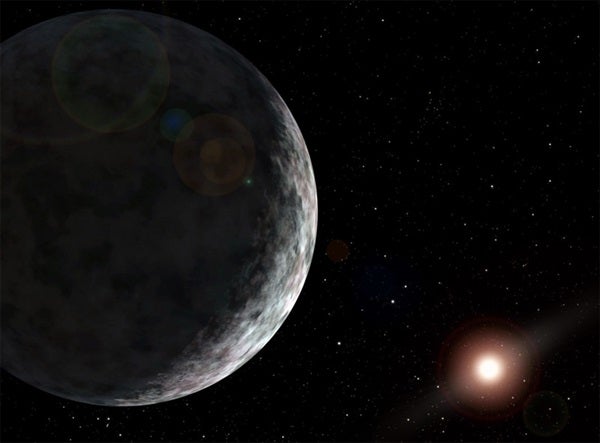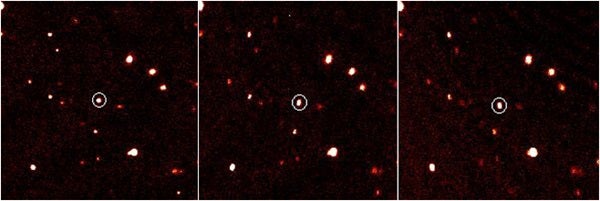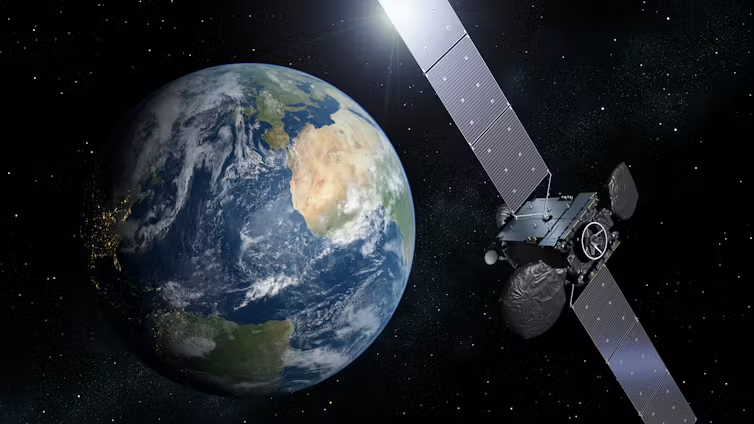Caltech astronomer Michael Brown announced late Friday that his team had discovered a new planet both larger and more distant than Pluto. The new object — dubbed 2003 UB313 — is the farthest directly observed body in the solar system and the fourth brightest Kuiper Belt object.
Not all astronomers agree with the team’s planetary claim, despite NASA’s apparent approval. During the past few years, many researchers — Brown among them — have argued Pluto itself should no longer be classed as a planet. But, he now reasons, if we’re comfortable conferring planetary status on Pluto, it’s inconsistent to deny the title to even larger bodies.
Pluto orbits the Sun with hundreds of other objects in the Kuiper Belt, a region between 30 and 50 AU from the Sun. One AU equals Earth’s distance from the Sun, 92.96 million miles (149.6 million km).
| Orbit of 2003 UB313 | |
| Eccentricity (e): | 0.4416129 |
| Semi-major axis (a): | 67.7091 AU |
| Perihelion (q): | 37.808 AU |
| Aphelion (Q): | 97.610 AU |
| Orbital period (P): | 557 years |
| Inclination (i): | 44.177° |
| Ascending node (Ω): | 35.8750° |
| Argument of perihelion (ω): | 151.3115° |
| Mean anomaly (M): | 197.5379° |
| Click here for an ephemeris. | |
I sat in this same room and talked about another object that at the time was the most distant object known in the solar system — the planetoid Sedna,” he said. “This object is just a little bit beyond Sedna and sets a new record for distance.”
Sedna never approaches closer than 76 AU to the Sun and is currently 98 AU away. At the far end of its 11,500-year orbit, Sedna reaches a distance of 943 AU.
2003 UB313 now lies 97 AU from the Sun — over 9 billion miles (14.5 billion km) — and has reached the farthest part of its 560-year orbit. About 280 years from now, it will reach its closest point to the Sun at a distance of 38 AU.
Why wasn’t it found before? Unlike most planetary orbits, which lie more or less in the ecliptic plane, 2003 UB313 rides an orbit tilted 44° out of this plane. “Nobody looks that high up in the sky for these sorts of objects,” Brown explained. “The only reason we’ve been looking that high is because we’ve looked everywhere else so far.”
The team first imaged the new planet October 31, 2003, with the Palomar Observatory’s 48-inch Samuel Oschin Telescope as part of a systematic survey. But the object moved so slowly the astronomers didn’t notice its motion until they reanalyzed images January 5, 2005.
“I think it’s cool,” said Alan Stern, an astronomer at the Southwest Resarch Institute in Boulder, Colorado. He’s also the principal investigator on NASA’s New Horizons mission to Pluto, set to launch next year. “I don’t think it’s surprising.”
In a 1991 paper, Stern predicted the Kuiper Belt and the Oort comet cloud together harbor 1,000 objects larger than Earth. “Uranus and Neptune got their axial tilts from collisions with objects this big. For every one that hits, many miss.” Some of these must still be stored in the outer solar system.
“I think [asteroid] Ceres should be considerd a planet,” he said. “I think anything big enough to make itself round due to gravity should be considered a planet.”
Stern thinks people should get used to the idea our solar system has dozens of planets. “I think the floodgates are open now, and in 10 years we’ll have a whole bunch of these little guys.” He calls them dwarf planets. Just as the galaxy’s most common stars are cool dwarfs much smaller than our Sun, we may find, Stern says, that small iceballs are the galaxy’s most common type of planetary body.
Brown told reporters in Friday’s teleconference that his team has been studying the new planet “with as many telescopes we could in preparation for this announcement.”
On January 25, Trujillo obtained a near-infrared spectrum, which provides information about the planet’s surface properties, with the Gemini North Telescope on Mauna Kea, Hawaii. Preliminary results show a surface covered in frozen methane, one remarkably similar to Pluto’s. The presence of methane ice suggests a primitive surface that probably hasn’t been heated significantly since the solar system formed 4.5 billion years ago.
“If 2003 UB313 ever got close to the Sun, all the methane ice would have boiled off immediately,” explained Trujillo.
“No other object in the Kuiper Belt has a surface that looks like that,” Brown said. However, the new object appears nearly gray in color, while Pluto is somewhat red. The team has no explanation for this difference yet.
The amount of light the planet reflects puts a lower limit on its size. But, said Brown, “Even if it reflected 100 percent of the light reaching it, it would still be as big as Pluto.” However, there is no substance known this reflective, and the less shiny the object’s surface is, the larger it must be. If 2003 UB313 reflects 90 percent of sunlight — the same as a fresh snowfall on Earth — Brown says its size would be a few percent larger than Pluto.
He estimates 2003 UB313 is about one-and-a-quarter times the size of Pluto, or about 1,777 miles (2,860 km) across.
Attempts to detect the new body using the heat-sensing Spitzer Space Telescope have been unsuccessful so far, but the astronomers are continuing their analysis. Lack of a detection with Spitzer places an upper limit on the body’s size. The team says 2003 UB313 cannot have an overall diameter greater than 2,206 miles (3,550 km).
The team plans to view the object with the Hubble Space Telescope soon.
The object’s current name is temporary but Brown said his team has submitted a permanent name to the International Astronomical Union, the organization that approves solar system nomenclature. He did not wish to disclose the proposed name until it is accepted.
“It will be visible over the next six months and is currently almost directly overhead in the early-morning eastern sky, in the constellation Cetus,” Brown noted. He estimated an amateur astronomer with a 14-inch scope, a CCD camera, and a dark site should be able to detect the new object.











